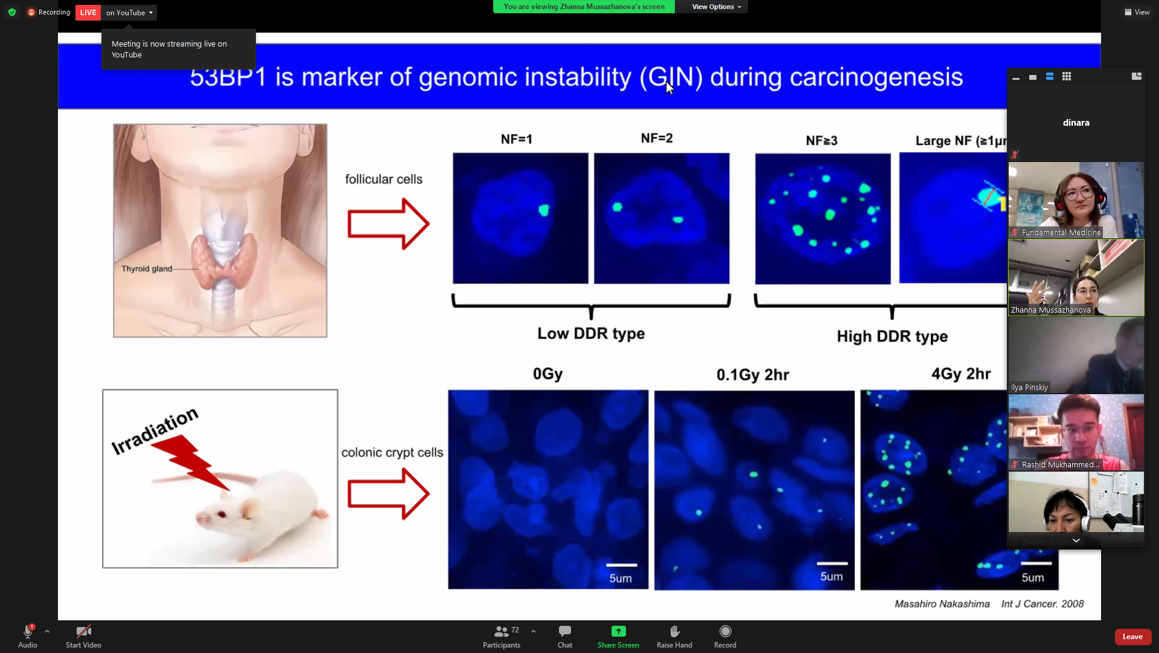Today, 28.05.21, a number of events were held within the framework of the ISMS 2021 symposium
Views: 1648

Today, 28.05.21, a number of events were held within the framework of the ISMS 2021 symposium, a master class was held by a scientist from the University of Nagasaki PhD Musazhanova Zhanna Bakhytgereevna on the topic "Immunofluorescence analysis of DNA damage response protein p53-binding protein 1: molecular indicator of genomic instability in human carcinogenesis" ... The topic was very relevant, there were students, young scientists and medical practitioners.
Students asked questions, showing their interest, the practicing cytopathologist Eleubaeva Zhanara Bolatovna noted the relevance of the master class for practical health care. Zhanna Musazhanova talked about markers, the state of the norm and pathology. She also shared her research and results. (https://youtu.be/2NRmwvebAm0)
Also, there was a preliminary lecture by Professor Sheriff Karam. On the topic "Biology of gastric stem cells in diseases." (https://youtu.be/wlh1MlibiTs)
He talked about his studies of the stomach. The significance of stem cells, and the state of the stomach is normal and the transition to pathology. He talked about experiments on mice. How the stomachs of mice reacted to radiography. I also considered these processes by age.
On the section “ORGAN AND SYSTEM; TISSUE AND CELL MORPHOLOGY; CARDIOVASCULAR SCIENCE; NEUROSCIENCE ”was chaired by Serena Bianchi, Assistant Professor of Anatomy at the University of L'Aquila, Italy.
Nikolai Nikolaevich Shevlyuk, histologist, doctor of biological sciences, professor of the Department of Histology, Cytology and Embryology of the Orenburg State Medical University, made a report on reactive and adaptive changes in the gonads in mammals of the urban ecosystem.
Lyashchenko Diana Nailevna, MD, DSc, Head of the Department of Human Anatomy, Orenburg State Medical University, demonstrated 2 excellent sectional materials: 1) anatomy of the heart and prenatal fetal shunts at 16-22 weeks of development; 2) anatomy of the skull base and hindbrain in the fetus at 20-22 weeks of development.Then they listened to the report of Doctor of Medical Sciences, Associate Professor Lyashchenko Sergey Nikolaevich, Vice-Rector for Scientific, Innovative and International Activities of the Orenburg State Medical University, on experimental plastic surgery of the kidney bed after its removal in order to prevent morphological changes in surrounding organs.
The last speaker, Erin Hutchinson of the School of Anatomical Sciences, Faculties of Health Sciences, University of the Witwatersrand, Johannesburg, South Africa, presented a presentation on the quality of mandibular bone in tooth development in young children.The moderators of the “Poster section 28.05” section were Professor Al Azhar Medical University Hospitals, Faculty of Neurosurgery Mahmoud Farid Mahrous Bathalla (Cairo, Egypt) and Professor of West Kazakhstan Medical University named after Marat Ospanov Smagulov Gaziza A. (Aktobe, Kazakhstan).
At the session of the section, 9 poster reports were heard, among which: 2 reports were made by a participant from Azerbaijan, 2 - by participants from Russia, 5 - by participants from Kazakhstan.
Link to the recording of the poster section meeting on Youtube https://youtu.be/hobCaOf0fPM
|
Nigar Mustafayeva (Baku, Azerbaijan) |
The gender differences of the orbit |
|
Ramila E. Babaeva (Baku, Azerbaıjan) |
Morphology and function of unpaired visceral branches of the abdominal aorta |
|
Lyudmila O. Shalikova (Orenburg, Russia) |
Anatomy of the sacral spine and its relationship with adjacent neural pelvic structures in human fetuses 16-22 weeks of development |
|
Rafik T. Nigmatullin, Bulat Motygullin (Ufa, Russia) |
Anatomical - biomechanical correlations in elastin structures |
|
Nurkanat A. Zhumabay (Aktobe, Kazakhstan) |
Features of vascular endothelial myocardial infarction and adverse biochemical markers in environmental impacts |
|
Gulnar S. Gabdullina (Nur-Sultan, Kazakhstan)
|
Tracheobronchial lymph nodes of fetuses and newborns with chronic intrauterine hypoxia in early ontogenesis |
|
Yerlik M. Serkesh (Nur-Sultan, Kazakhstan) |
Assessment of conformity of “biological” age to “chronological” data in children of kazakh ethnic group in astana |
|
Gulzira K. Sagimova (Nur-Sultan, Kazakhstan) |
Changes in the cellular composition of the spleen of fetuses and newborns in early ontogenesis in gestosis with anemia in pregnant women |
|
Gulnara A. Temirova (Aktobe, Kazakhstan) |
Histological method for detecting bodies in the thymus gland |
The next section is “BODY DONATION: A GLOBAL PERSPERCTIVE IN A ROUND TABLE DISCUSSION”. Chaired by Beverley Kramerfrom the University of the Witwatersrand.
In this section, participants led a discussion on the topic of body donation in different endeavors. Including Tamar Abaeva from Kyrgyzstan told about the situation in the neighboring country.
There were also speakers from China, Argentina, Portugal, Africa and Italy.The symposium will run until May 30th. In the following days, all listeners have the opportunity to watch lectures on our YouTube channel. https://youtube.com/playlist?list=PL8onlaAm1VBCf_j2higVlSPpIzNgKtEv_








